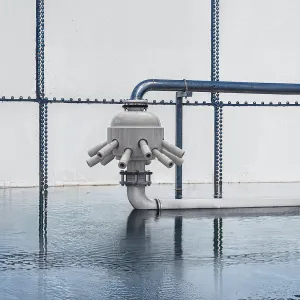Körting Hannover GmbH
Booth number: H7-A205
www.koerting.de
About us
The original product. Made in Germany.
Sustainability has become an important goal, particularly for many companies in the textile industry. Körting technology allows textile companies to introduce sustainability into the mercerisation process. Due to the recovery process, the plant operator doesn’t have to bother disposing of the weak lye. The environment benefits directly. Because the lye can be reused, savings of one million euros and more per year are possible. The CRP can show a return on investment within one year. As a result, plant operators can permanently cut the overheads incurred from mercerisation. When designing the plant, Körting engineers already include the savings potential in the calculation.
In the 1950s, Körting engineers developed the first CRP for textile processes. The first CRP was commissioned back in 1956. Over the past almost 60 years, over 200 plants have gone into operation in more than 50 countries. Across the world plant operators place their trust in the experience and reliability of Körting plants. Quality made in Germany isn’t just sought after in Europe, but also in the world’s up-and-coming textile nations. No other company has been involved in manufacturing CRP for as long as Körting Hannover GmbH.
Address
Badenstedter Str. 56
30453 Hanover
Germany
E-mail: info@koerting.de
Phone: +49 511 2129-0
Internet: www.koerting.de
No. 15, Xiaguangli
Room 1609, Xiaoyun Center, Chaoyang Dist.
100125 Beijing
China
E-mail: info@koerting.cn
Phone: +86 10 84585020
Internet: www.koerting.de/en
7, 8th Street
Dr. Radhakrishnan Salai
600004 Mylapore, Chennai
India
E-mail: info@koerting.in
Phone: +91 44 284 757-61/-62
Internet: www.koerting.de/en
Plaza Mont´Kìara No.2, Jalan Kiara, Mont´Kiara
Suite B-08-04
50480 Kuala Lumpur
Malaysia
E-mail: khsiow@koerting.com.my
Phone: +60 3 6201-0130
Internet: www.koerting.de/en
Contact person:
Products & Services
Körting Hannover GmbH has been a supplier of engineering services, components and systems for process engineering plants for more than 150 years. Benefit from many years of experience, expertise and the continuous further development of Körting products. Customized solutions can be implemented with Körting's know-how, from concept development and component supply to ready-to-use plants.
Caustic Recovery Plants (CRP)
Mercerisation is a finishing process in the textile industry where the textile fibres are treated under tensile stress with caustic soda. Large quantities of diluted caustic soda (weak lye) are a waste product of this process. Körting Caustic Recovery Plants (CRP) can turn a very large proportion of this weak lye into reusable concentrated caustic soda (strong lye). Körting Hannover has been on the market longer than any other manufacturers in this field and is the global market leader of CRP.
Sustainability has become an important goal, particularly for many companies in the textile industry. Körting technology allows textile companies to introduce sustainability into the mercerisation process. Due to the recovery process, the plant operator doesn’t have to bother disposing of the weak lye. The environment benefits directly. Because the lye can be reused, savings of one million euros and more per year are possible. The CRP can show a return on investment within one year. As a result, plant operators can permanently cut the overheads incurred from mercerisation. When designing the plant, Körting engineers already include the savings potential in the calculation.
Körting CRP are not just limited to white bleached fabrics. They can also be used for yarn-dyed and denim fabrics.
Ejectors for waste water aeration
Ideal for plants with highly polluted waste water
The design of the ejectors for the aeration process corresponds to that of a usual jet ejector. The air to be introduced is compressed in advance. Because of the high oxygen demand of organically polluted waste water and the increasing heights of modern biological waste water treatment plants it is energetically more efficient to pre-compress the air mechanically to the hydrostatic pressure prevailing at the installation point of the ejector and to supply it so to the suction connection. This waiving of a considerable pressure gain in the ejector reduces its necessary motive pressure. At the same time, more favourable mixing ratios (suction flow : motive flow) are achieved.
Körting ejectors are equipped with a non-clogging spiral inside their motive nozzles. The motive jet thus disperses the air already at a low motive pressure in a myriad of fine bubbles which are then mixed vigorously together with the motive flow in the mixing element. This air/water mixture is injected into the aeration tank with a high turbulence. In this way the ejector guarantees optimum oxygen supply and a complete intermixing of the whole tank contents. Even with a high biomass concentration in the waste water it is still possible to attain flow velocities which prevent deposits on the bottom of the aeration tank.







